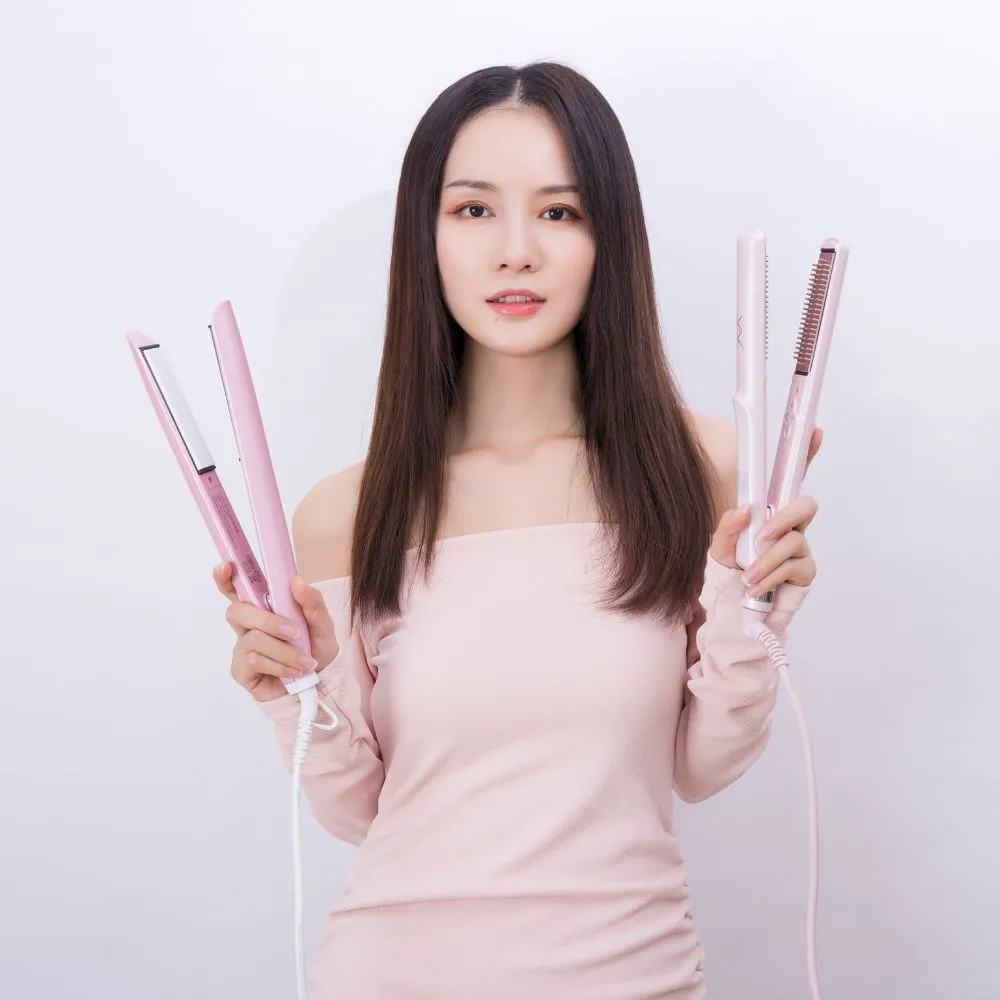Have you ever wondered if you can flat iron synthetic hair? Synthetic hair is made from various types of plastic fibers that are designed to mimic real human hair. However, when it comes to heat styling, there are some considerations to keep in mind.
Synthetic hair is known for its ability to hold a style, but can it withstand the heat of a flat iron? Many people are curious about this, but it’s important to understand the potential risks and limitations of using heat on synthetic hair.
In this article, we will explore the possibility of flat ironing synthetic hair, the risks involved, and alternative styling methods. Additionally, we will discuss how to properly care for synthetic hair to maintain its quality and integrity.
Background on synthetic fibers and their properties
Synthetic hair wigs, crafted from artificial hair integrations, are praised for their heat resistance and convenience. These fibers have evolved to withstand heat up to a commendable 400 degrees. Their resilient nature allows the use of hair straighteners, provided caution is exercised not to exceed advisable temperatures lest you risk altering their inherent qualities. For those who invest in pre-styled synthetic pieces, straightening might be a one-way ticket to a permanent texture change; hence, awareness and acceptance of this are crucial.
The intricacies of monofilament top wigs grant the wearer the liberty to part and style with the gentle warmth of a blow-dryer. Yet, this process beckons a delicate hand to prevent damaging the fibers. The marvel of synthetic wigs lies in their “style memory,” a feature ensuring they unfailingly rebound to their designed form post-wash. However, imposing heat in restyling may imprint new memory on the wig, reshaping its default state.
In summary, synthetic wigs offer stability in style and a reprieve from the rigors of incessant cleansing, marking them as a robust option in the realm of non-surgical hair replacement.
Can synthetic hair be flat ironed?
When contemplating the possibility of flat ironing synthetic hair, it is important to recognize that not all synthetic fibers are created equal. Heat-resistant synthetic wigs are specifically designed to endure the heat of styling tools, including hair straighteners. However, it is paramount to verify the nature of the wig by checking the label or conducting a strand test beforehand, as applying heat to non-heat-resistant synthetic hair can result in irreversible damage. For those who own wigs that do not tolerate high temperatures, alternative methods such as using a hair dryer on a low, warm setting or a clothes steamer can provide more gentle straightening effects.
High-quality human hair wigs and extensions, often referred to as ‘Intriguing Hair’, may offer a greater degree of versatility when it comes to heat styling. But for synthetic wigs, the ability to flat iron hinges on the fiber’s heat tolerance. While heat-friendly synthetic wigs give room for customization, it is crucial to exercise caution and adhere to the specified heat limitations to maintain the integrity and appearance of the wig.
The potential risks of using heat on synthetic hair
Exposing synthetic hair to heat, particularly if it is not heat-resistant, can have detrimental effects. A synthetic hair wig, often mounted on a wig head or a styrofoam head for styling, can experience melting, singeing, or burning when subjected to high temperatures. This is because traditional synthetic wigs are typically made of plastic fibers that do not withstand the heat produced by a hair straightene or curling iron.
If one is not cautious, a heated styling tool can instantly alter the layer of hair, changing its texture and appearance beyond repair. This risk is magnified in the case of cheaper synthetic wigs, as they generally possess a lower threshold for heat. The fibers can frizz or distort when heat is applied, which could mirror the effects of hair loss due to the patchiness and uneven texture that may result.
Beyond the direct application of styling tools, even ambient sources of high heat such as ovens or outdoor heaters can pose a threat to synthetic hair wigs. As such, when wearing a synthetic wig near such heat sources, it’s advisable to maintain a safe distance.
Tips for safely flat ironing synthetic hair
Flat ironing a synthetic wig that is deemed heat-resistant requires careful preparation and technique to avoid damage. Here are some tips for a safe straightening process:
- Read Instructions and Heat Test: Always start by reading the care instructions that come with your heat-resistant synthetic wig. Perform a strand test by applying heat to a small piece of hair to ensure it doesn’t melt or frizz.
- Use Suitable Tools: Select a flat iron with adjustable temperature settings and use it on the lowest heat setting that is effective. A wide tooth comb can also be used alongside to gently untangle the fibers without pulling.
- Prepare the Wig: Secure the wig on a wig head and brush it using a paddle brush or comb to remove any knots. Divide the wig hair into sections using hair clips to manage the straightening process more effectively.
- Straighten Gradually: Begin by ironing a lower layer of hair, slowly moving the hair straightener from the roots towards the ends. Avoid holding the heat on any section for too long.
- Cool Down: After straightening, allow the wig to cool before touching or styling further. This will help set the straightened hair and prevent immediate re-curling or waving.
- Finish with Care: Optionally, apply a leave-in conditioner suitable for synthetic hair to add some shine and reduce static electricity. Brush through with a wide-toothed comb for a smooth finish.
By adhering to these guidelines, you can help ensure a successful straightening process that could enhance the longevity and appearance of your synthetic wig.
Alternatives to flat ironing synthetic hair
For wig enthusiasts seeking to style synthetic hair without the risk of damage from a flat iron, exploring alternative methods is crucial. These approaches cater to both medium- to high-quality synthetic wigs, as well as more affordable options, all without compromising the integrity of the fibers.
Using alternative heat styling methods
Heat-resistant synthetic wigs allow for some versatility in styling, with the possibility of using gentle heat to achieve a straight look. A hair dryer set to a low or cool setting can be used in combination with a wide-toothed comb or brush to straighten the wig hair gradually. By carefully brushing and directing the airflow from ends to roots, you can minimize heat exposure while attaining smoothness.
For synthetic wigs that don’t tolerate direct heat, steaming presents a viable option. A clothes steamer can be used to release waves and curls by hovering over sections of the hair and gently pulling straight with a comb. This method allows for controlled heat application, reducing the risk of overheating the fibers.
Moreover, hot water can serve as an alternative for straightening cheaper synthetic wigs. By submerging the wig in a pot of water just below boiling temperature, the fibers can relax and extend. After immersing the wig, allowing it to cool and gently brushing the hair can lead to straighter strands. This technique, however, should be preceded by a strand test to ensure the wig’s material can indeed handle the hot water without deteriorating.
Exploring non-heat styling options for synthetic hair
Beyond the application of heat, numerous non-surgical hair replacement options exist for modifying synthetic hair. Specialized wig-friendly styling products can give synthetic wigs a fresh look without risking the integrity of the fibers. For instance, mousse, spray, or gel designed for artificial hair integrations can be applied to define and hold the desired shape.
Accessories such as rollers, clips, and braids open doors to a world of styles that don’t require heat at all. With patience and creativity, one can employ these tools to reshape synthetic hair overnight or over a couple of hours, relying on the hair’s natural ability to conform to new shapes when held in position for extended periods.
When styling, it is paramount to guard against potentially destructive environmental heat. Synthetic wigs should be shielded from high temperatures emanating from ovens, outdoor grills, or intense sun exposure. By utilizing these non-heat methods, those dealing with hair loss or simply looking to diversify their wig-wearing experiences can do so safely and with confidence.
Caring for synthetic hair
Proper maintenance and cleaning are at the heart of prolonging the life of synthetic hair, whether you are dealing with wigs or extensions. Before any style considerations, it is essential to wash and gently detangle the synthetic fibers using a wide-toothed comb. This initial step is crucial in preserving the hair’s quality and preparation for further care and styling. Once the wig is detangled, spray it evenly with a wig-specific leave-in conditioner to enhance moisture and make future combing easier. Rather than wringing out the water, which can create additional tangles and compromise the hair fibers, it’s advised to blot the wig dry with a towel.
Proper maintenance and care for synthetic wigs and extensions
After washing and conditioning, air drying your synthetic wig is paramount to maintain its shape and texture. When air drying, place the wig on a plastic wig stand or even a household tool such as a roll of paper towels to keep its form. Avoid heat styling tools on standard synthetic wigs, as the likelihood of burning or melting the plastic fibers is high. Instead, for maintenance and styling, a Styrofoam or canvas wig head can be beneficial. Using T-pins to secure the wig in place, you can gently adjust the style with shaping creams or light hold products that won’t weigh down the fibers.
In fact, one of the remarkable features of synthetic wigs is their style memory, which means after washing, they can return to their original form with little to no additional styling needed. To capitalize on this feature and extend the life of your wigs, alternating between a couple of wigs can be a smart practice, as frequent washing and restyling can shorten their lifespan.
Recommended products for preserving the integrity of synthetic hair
When it comes to selecting products for synthetic hair, choosing the right ones can significantly affect the fiber’s condition. Using heat protectant products is imperative if you plan to use heat on heat-resistant synthetic wigs—these function by locking in moisture and forming a barrier that minimizes heat damage. For daily maintenance, lightweight oils or creams can keep the hair smooth without the risk of build-up.
For detangling and preventing static, spritzing the hair with water from a spray bottle and passing through with a wide-toothed comb can work wonders. In addition, using leave-in conditioners specifically formulated for synthetic fibers will help maintain their softness and luster. Remember to ensure that your wig stand is appropriately shaped to preserve the integrity of the wig, preventing unnecessary stress on the hair fibers and helping to keep its styled shape intact over time.
By adhering to these user-friendly care techniques and choosing suitable product recommendations, you can enjoy the beauty of your synthetic hair enhancements for an extended period.

